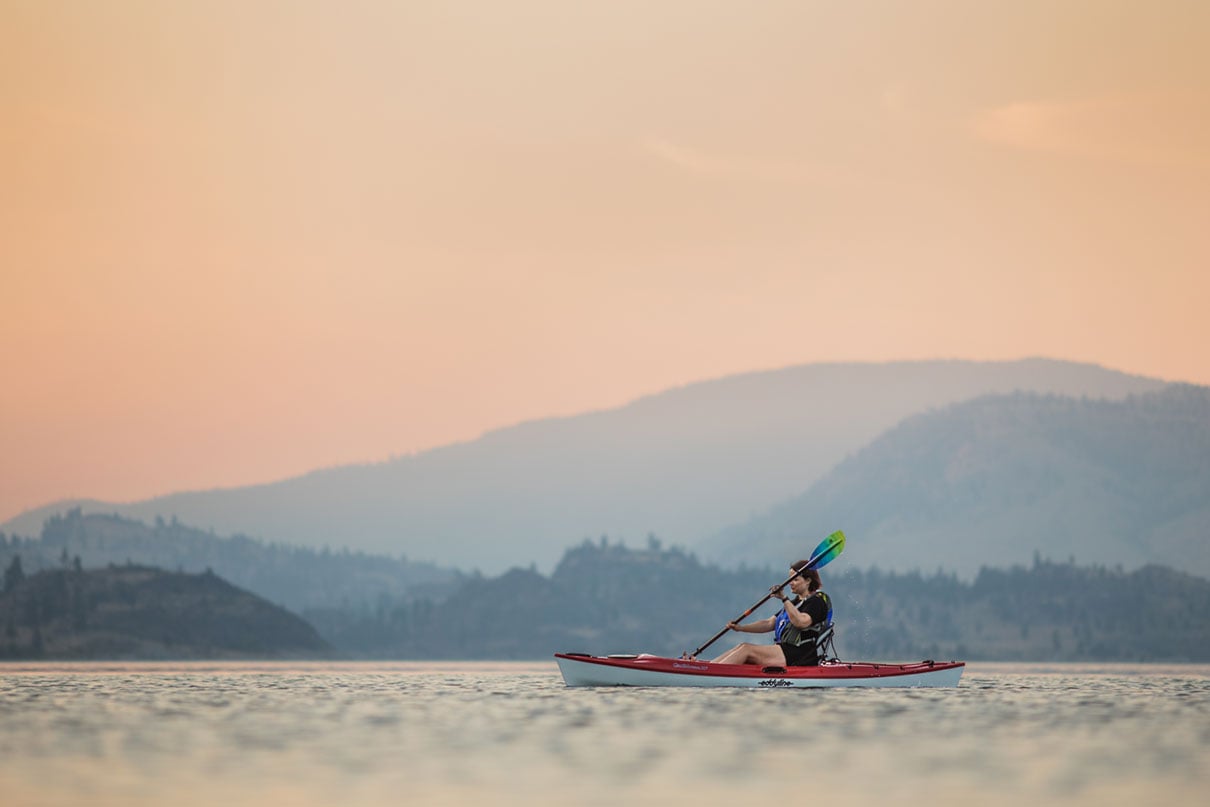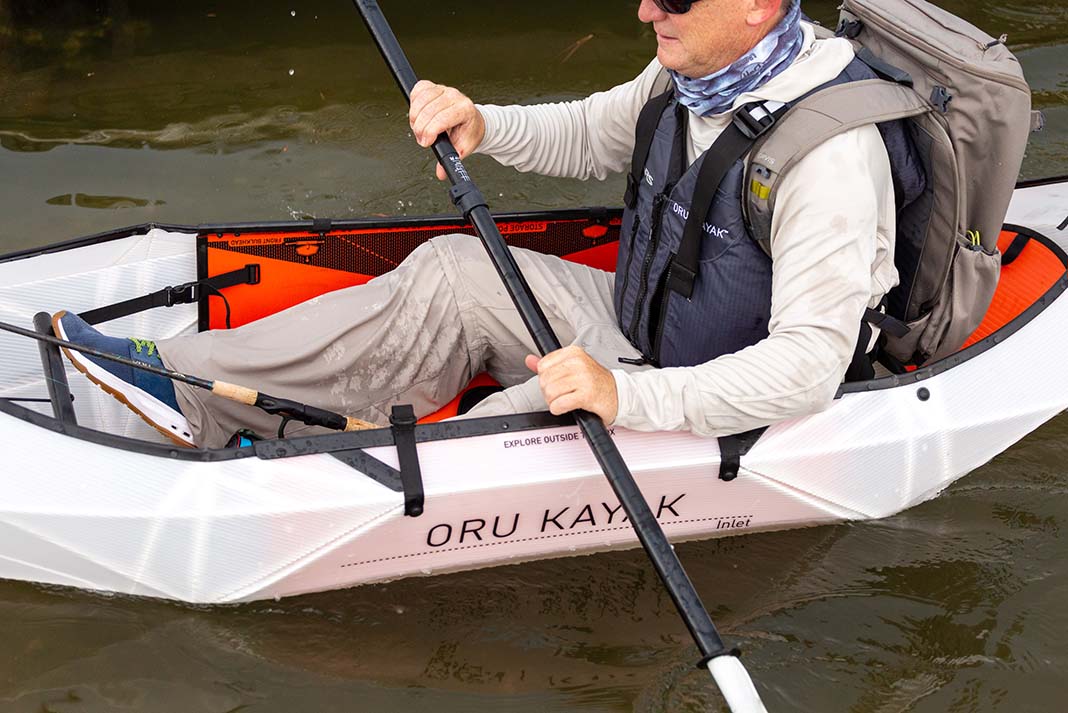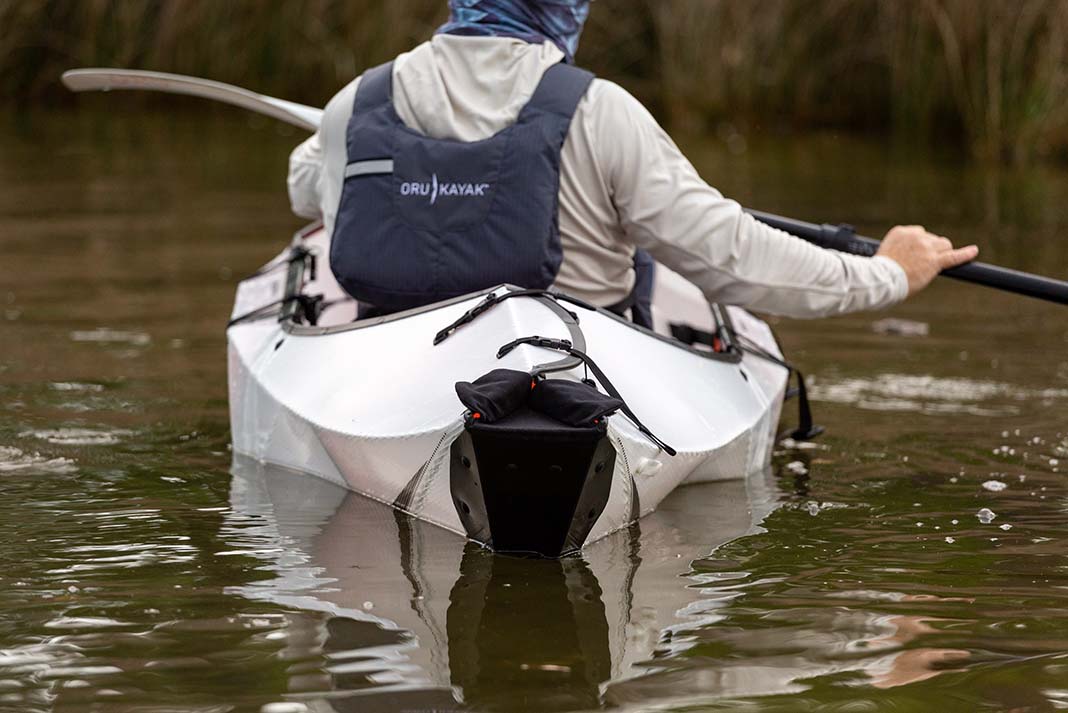If I told you my fishing kayak weighs 20 pounds, is only nine feet, eight inches long and has a 275-pound capacity, you would look at me like I just landed from the planet Ork. To tell the truth, the first time I saw the Oru Inlet folding kayak, I thought it arrived to Earth in a giant egg.
Picture this: a kayak made out of translucent corrugated plastic sheets folding like an origami swan. The only accessory is a simple gel seat in the bottom of the cockpit. Unhook several buckles, loosen a bungee cord and the boat collapses to make its own carrying case. Wherever it arrived from, the unusual Oru Inlet landed a spot on Paddling Mag’s list of best kayaks.
Oru’s Inlet is an out-of-this-world folding boat
Oru Inlet Specs
Length: 9’8”
Width: 31”
Weight: 20 lbs
Capacity: 275 lbs
MSRP: $899
orukayak.com
Turns out, Oru didn’t come from another galaxy, the concept came from Anton Willis, Oru’s chief design officer. “The idea for Oru Kayaks started when I moved into an apartment and had to put my kayak into storage,” Willis says. He remembers reading a magazine article about origami and then folding paper into kayak shapes.
After 25 prototypes and three years working nights and weekends on the project, the first origami-inspired kayak hit Kickstarter in 2012. Since then, Oru have released five models from a 16-foot-long touring kayak to a 500-pound-capacity tandem. The Inlet is the lightest and least expensive Oru, with a short waterline and wide open cockpit for fishing.
“We’re always making our boats more accessible, that means price as well as portability,” Willis says. As the least expensive Oru model, and the lightest, the Inlet is on its way to meeting this goal.
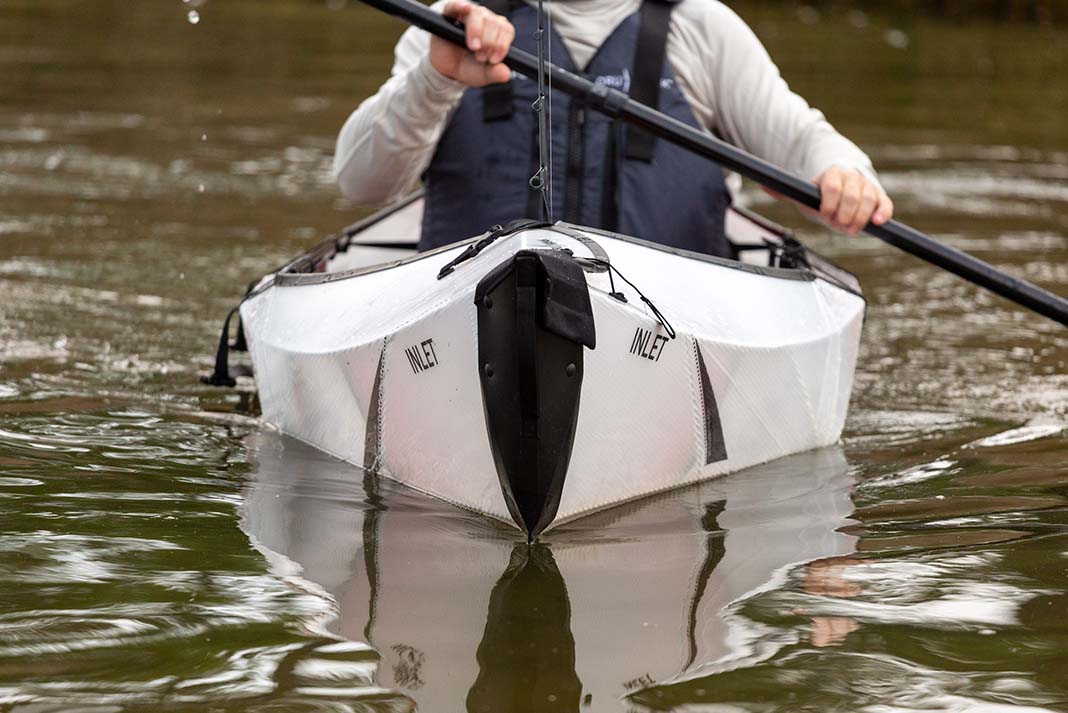
The Oru concept wasn’t only inspired by origami. Willis was committed to designing a kayak that performs as well as it packs up. The Oru hull recalls the designs of traditional Inuit kayaks built out of animal skins stretched across a wooden frame. The folds in the Oru’s body act like a frame to give the boat its rigidity.
The Inlet’s open cockpit makes it the best model for fishing. There is room behind the seat for tackle boxes and gear with space in front of the seat to land a fish or take a small kid or pet for a ride.
Assembling the Oru Inlet
The origami kayak’s advantages were apparent when the boat arrived in a single box the size of a large suitcase. Opening the box, I found the Inlet, a four-piece paddle, life vest and the seat.
Once the boat was out of the box, I spent about 15 minutes putting it together. Before attempting to insert slot B into tab A, I watched an instructional video on Oru’s website. The instructions are also printed on the boat’s floor.
Compared to just pumping up an inflatable kayak, unfolding the Inlet was more complicated but a lot easier and faster. Oru uses a corrugated plastic like heavy-duty, waterproof, puncture-resistant cardboard. The rigid panels pop into place along pre-creased folds.
The combination of stiff material and strategically placed folds gives the kayak its shape. Then, a series of straps and bungees hold it together. The seat straps into the cockpit and a bungee holds the foot brace. Hard plastic fairings on the bow and stern increase rigidity and toughness while improving hydrodynamics.
Easy to transport and store
Once the boat is built it looks pretty cool. The traditional kayak roots are visible in the rigid folds and flat panels. The white body and black accents are sharp with orange bulkheads and floor for some spice.
I was won over when I lifted the Oru over my head. I could easily carry the boat across a shoulder instead of dragging it. The size and weight were liberating. In addition to fitting into a car trunk and broom closet, the boat is easy to store in the yard and load assembled on a roof rack or pickup truck.
“We’re always making our boats more accessible,
that means price as well as portability.”
So, does the Oru work? First, a word about expectations. The Oru fits in the category of easy-to-transport-and-store kayaks along with inflatables and other folding kayaks.
All boats in this category are subject to limitations. Inflatable boats often suffer from poor performance owing to the boat’s lack of rigidity. Using a rigid hull, folding kayaks such as Uncharted Outbound or Point 75 KingFisher improve performance. But these boats aren’t as portable as an inflatable and the performance still isn’t as good as a traditional kayak.
The Oru strives to beat the portability of an inflatable and performance of other folding kayaks.
As for portability, the Inlet gets top marks. Lighter than an inflatable and easier to assemble, I was able to build the Inlet without breaking a sweat. The kayak folds into its own carrying case, so it is a lot easier to move and the boat can store in a small closet or under a bed. The Inlet can even carry a travel paddle and life vest in one package.
Compared to other folding kayaks, the Inlet is lighter and smaller, even if it is a little more complicated to construct. The Outbound and Kingfisher will fit in a hatchback, I can stuff two Oru Inlets in the same space.
Oru Inlet on the water
On the water, the Inlet had a different story to tell. I have to admit, I was a little suspect of sitting in a paper-like kayak. I could see water through the transparent hull.
The low profile gel seat was comfortable and supportive. I could adjust the seat forward and back and recline the seat back with a series of straps. The foot brace suspends on three bungees and can be adjusted to dial in the fit.
Paddling the Inlet was a breeze. The 31-inch-wide boat scoots over the water with a sharp bow and stern keeping the kayak traveling straight. Turning the kayak is easy, even in tight places. At only 20 pounds with a nine-foot, eight-inch waterline, the Inlet will spin in its own length.
Fishing from the Inlet was more of a challenge. Even though I had the straps pulled tight and the bulkheads installed, the Inlet is very flexible. I feel like the open cockpit causes the boat to be less rigid. Turning around, making a cast and landing a fish caused the boat to flex and twist.
While the sensation was weird, flexing and bending wasn’t unsafe. I was able to paddle and fish fine. It’s just different, I guess.
Compared to a traditional kayak, the Inlet isn’t very stable. Leaning to the side causes the boat to dip until it catches on the secondary stability. A couple times I took a little water over the gunwale. Despite the wobbliness, with some trepidation I was still able to stand and fish.
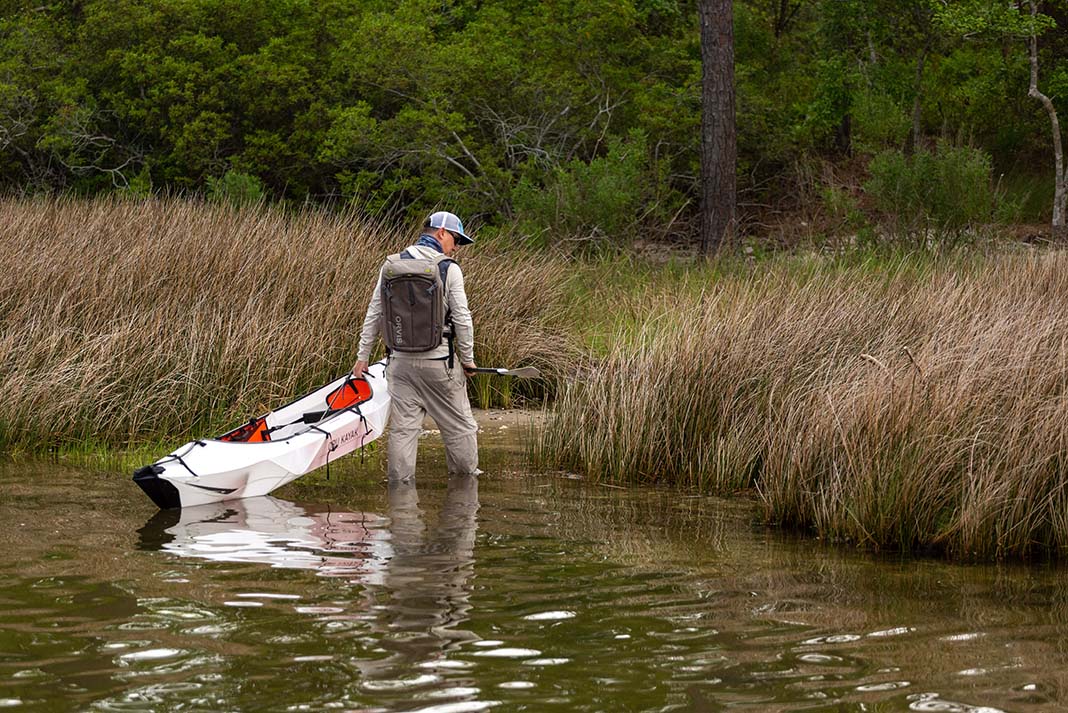
Surprisingly, the Inlet is tougher than it looks. The thin, translucent material seems like it would give way with the slightest bump. But I was able to drag the boat over rocks and crash into dock pilings. During the boat test, I intentionally abused the Inlet but never reached its breaking point. This boat may be light and thin, but it is pretty tough.
After a few trips, I grew accustomed to the Oru’s flexibility. The design is pretty solid and I never had a failure of the hull or flipped over. While the performance isn’t on par with a traditional plastic kayak, I would say it is as good or slightly better than an inflatable. With unmatched portability and slightly better paddling performance, the Inlet leads the category.
A vessel designed for urban paddlers
In addition to apartment dwellers and public transport riders, the Inlet is perfect for people looking to get on the water quickly and easily. Oru originator, Anton Willis says the boats are popular with millennials who are living life without cars and houses. “On the other end of the spectrum, older people love the Oru because they don’t have to lift a heavy kayak onto roof racks” Willis adds.
“People have had amazing
adventures in Oru kayaks.”
Willis says the best part of his job is hearing his customers stories. “People have had amazing adventures in Oru kayaks,” he says.
In fact, I would say many owners are able to take the trip of a lifetime because of the portable and functional Oru kayak. Kayak Angler’s favorite photographer, Dustin Doskocil took the original Oru down the famous Devil’s River in Texas. Both Dustin and the boat returned in one piece.
Get into the fold with the Oru Inlet
While the Inlet isn’t the best kayak for fishing, it is the best Oru model for fishing. So far. Willis hinted they are working on a fishing-specific model that will be more stable and stiffer with more features. “We’re looking for feedback,” he tells me. After enjoying the Inlet, I look forward to the next model.
Related articles
Oru kayak reviews
Folding kayak reviews
- Review: Klepper Folding Kayaks’ Aerius 545
- Folding Kayak Review: Oru Bay ST
- Folding Kayak Review: TRAK 2.0 Touring Kayak
- Folding Sea Kayak Review: TRAK Seeker ST 16
- Folding Kayak Review: Feathercraft Kurrent
- Folding Kayak Review: Pakboats Quest 135
Sit-inside fishing kayak reviews
- Kayak Review: Sun Dolphin Excursion 10
- Fishing Kayak Review: Ascend FS10
- Recreational Kayak Review: Pelican Trailblazer 100 NXT
- Fishing Kayak Review: Old Town Vapor 10
- Recreational Kayak Review: Sun Dolphin Aruba 10
- Fishing Kayak Review: Pelican Mustang 100x
- Inflatable Kayak Review: Advanced Elements AdvancedFrame Convertible Elite
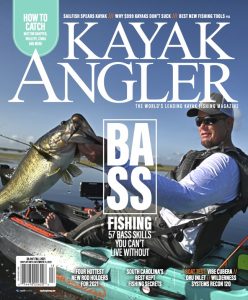
Grab and go anywhere with the Oru Inlet folding kayak. | Feature photo: Roberto Westbrook


